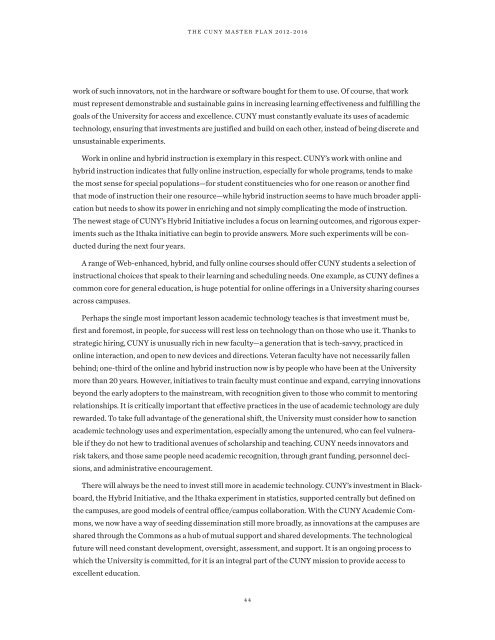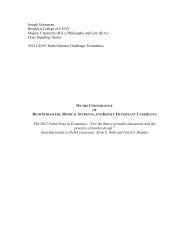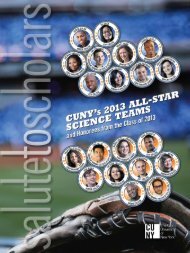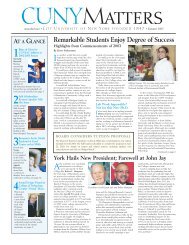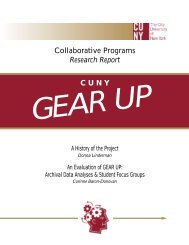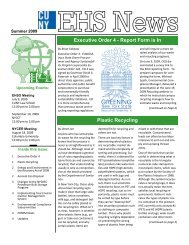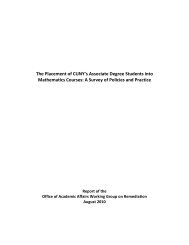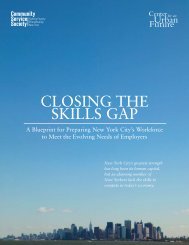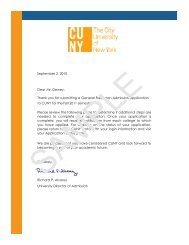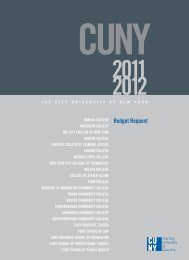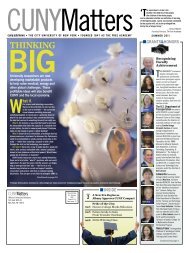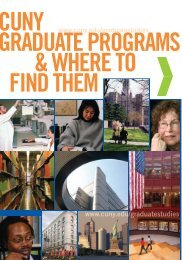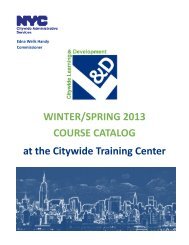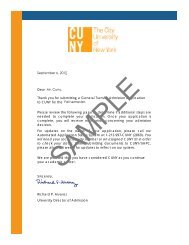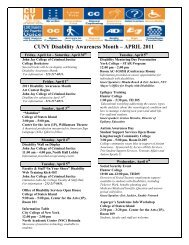CUNY Master Plan 2012-2016
CUNY Master Plan 2012-2016
CUNY Master Plan 2012-2016
You also want an ePaper? Increase the reach of your titles
YUMPU automatically turns print PDFs into web optimized ePapers that Google loves.
THE <strong>CUNY</strong> MASTER PLAN <strong>2012</strong>-<strong>2016</strong><br />
work of such innovators, not in the hardware or software bought for them to use. Of course, that work<br />
must represent demonstrable and sustainable gains in increasing learning effectiveness and fulfilling the<br />
goals of the University for access and excellence. <strong>CUNY</strong> must constantly evaluate its uses of academic<br />
technology, ensuring that investments are justified and build on each other, instead of being discrete and<br />
unsustainable experiments.<br />
Work in online and hybrid instruction is exemplary in this respect. <strong>CUNY</strong>’s work with online and<br />
hybrid instruction indicates that fully online instruction, especially for whole programs, tends to make<br />
the most sense for special populations—for student constituencies who for one reason or another find<br />
that mode of instruction their one resource—while hybrid instruction seems to have much broader application<br />
but needs to show its power in enriching and not simply complicating the mode of instruction.<br />
The newest stage of <strong>CUNY</strong>’s Hybrid Initiative includes a focus on learning outcomes, and rigorous experiments<br />
such as the Ithaka initiative can begin to provide answers. More such experiments will be conducted<br />
during the next four years.<br />
A range of Web-enhanced, hybrid, and fully online courses should offer <strong>CUNY</strong> students a selection of<br />
instructional choices that speak to their learning and scheduling needs. One example, as <strong>CUNY</strong> defines a<br />
common core for general education, is huge potential for online offerings in a University sharing courses<br />
across campuses.<br />
Perhaps the single most important lesson academic technology teaches is that investment must be,<br />
first and foremost, in people, for success will rest less on technology than on those who use it. Thanks to<br />
strategic hiring, <strong>CUNY</strong> is unusually rich in new faculty—a generation that is tech-savvy, practiced in<br />
online interaction, and open to new devices and directions. Veteran faculty have not necessarily fallen<br />
behind; one-third of the online and hybrid instruction now is by people who have been at the University<br />
more than 20 years. However, initiatives to train faculty must continue and expand, carrying innovations<br />
beyond the early adopters to the mainstream, with recognition given to those who commit to mentoring<br />
relationships. It is critically important that effective practices in the use of academic technology are duly<br />
rewarded. To take full advantage of the generational shift, the University must consider how to sanction<br />
academic technology uses and experimentation, especially among the untenured, who can feel vulnerable<br />
if they do not hew to traditional avenues of scholarship and teaching. <strong>CUNY</strong> needs innovators and<br />
risk takers, and those same people need academic recognition, through grant funding, personnel decisions,<br />
and administrative encouragement.<br />
There will always be the need to invest still more in academic technology. <strong>CUNY</strong>’s investment in Blackboard,<br />
the Hybrid Initiative, and the Ithaka experiment in statistics, supported centrally but defined on<br />
the campuses, are good models of central office/campus collaboration. With the <strong>CUNY</strong> Academic Commons,<br />
we now have a way of seeding dissemination still more broadly, as innovations at the campuses are<br />
shared through the Commons as a hub of mutual support and shared developments. The technological<br />
future will need constant development, oversight, assessment, and support. It is an ongoing process to<br />
which the University is committed, for it is an integral part of the <strong>CUNY</strong> mission to provide access to<br />
excellent education.<br />
44


